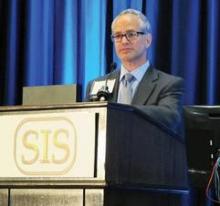BALTIMORE – A study of patients with intraabdominal infection indicates that a shorter course of antibiotics is as effective as the standard, longer course, leading researchers to recommend a new standard of care.
The rates of recurrent infections and other outcomes were similar in patients with intraabdominal infections treated with antibiotics for 4 days following source control and among those who received a longer course of treatment based on when their clinical symptoms resolved, in a study reported at the annual meeting of the Surgical Infection Society.
The results support the use of the shorter treatment strategy in this setting, said Dr. Robert Sawyer, who presented the results of the study, SIS Multicenter Study of Duration of Antibiotics for Intraabdominal Infection.
While antibiotics are used as an adjunct to treat intraabdominal infections, the appropriate duration of treatment is not clear, and reducing the time exposed to antibiotics "could be worthwhile," said Dr. Sawyer, professor of surgery and public health sciences and chief of acute care surgery at the University of Virginia, Charlottesville.
The randomized, multicenter, unblinded study compared a shorter vs. a longer course of antibiotic therapy in 518 patients with intraabdominal infections: 4 days in 258 patients or treatment that continued for 2 days after resolution of the patient’s fever, leukocytosis, and ileus, with a maximum of 10 days of treatment in total, in 260 patients. The patients had similar APACHE II scores; their mean age was in the early 50s; and the colon or rectum was the most common source of infection, followed by the appendix and the small bowel. Antibiotics were administered intravenously or orally. Patients with inadequate source control and a high risk of death within 72 hours were excluded.
Within 30 days, the primary outcome – a composite of surgical site infection, recurrent intraabdominal infection, and death – was similar between the two groups, at about 21.7% in the 4-day treatment group vs. 22.7% in the group treated for 2 days after symptoms resolved.
There were no significant differences in the individual endpoints between the two groups. There were also no differences in the composite endpoints in different subgroups, and when those with percutaneous drainage or patients whose source of infection was the appendix were excluded. Among sicker patients with APACHE scores of 10 or higher, there was a numerical benefit favoring those treated for 4 days (22.1% vs. 29.8% among those treated for the longer duration), but the difference was not statistically significant, although it was reassuring, Dr. Sawyer said.
There were no differences between the two groups in the rates of secondary infections or subsequent infection with resistant pathogens or Clostridium difficile, which were secondary endpoints.
Based on these results, "after source control is obtained, we recommend 4 days of antimicrobial therapy for all patients with intraabdominal infections as the new standard of care," Dr. Sawyer concluded.
Although they had positive comments about the study, several members of the audience commented that a larger study would be a better base for a recommendation to change the standard of care.
This study was one of several studies presented at the meeting that addressed the issue of reducing the time on antibiotic therapy in patients with surgical infections.
The study was sponsored by the National Institutes of Health. Dr. Sawyer had no disclosures.


